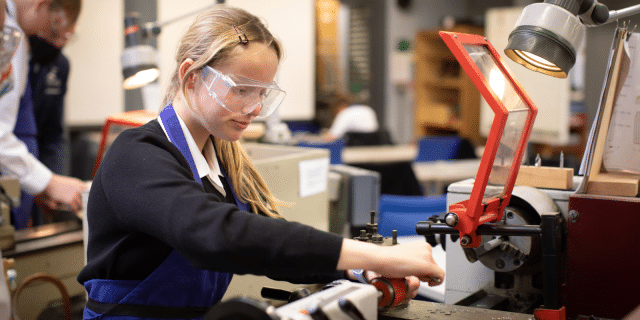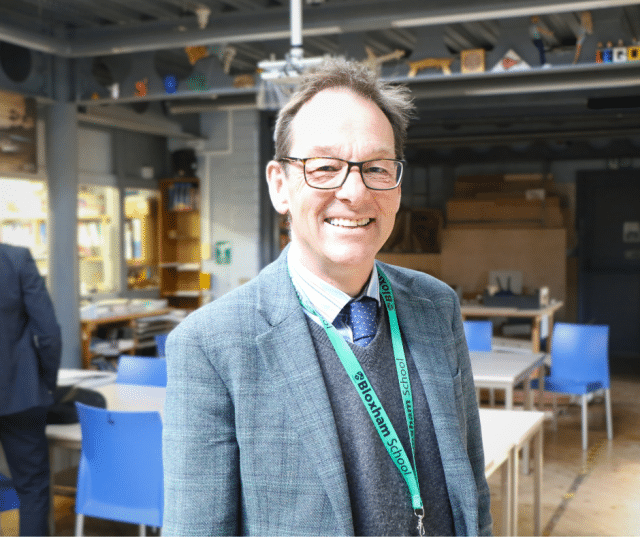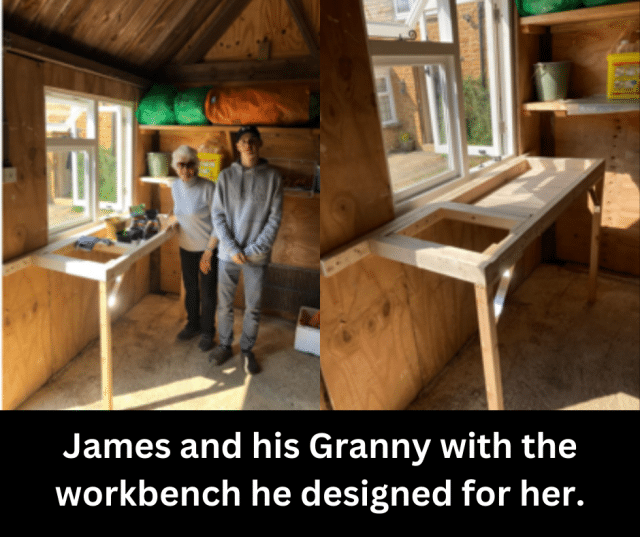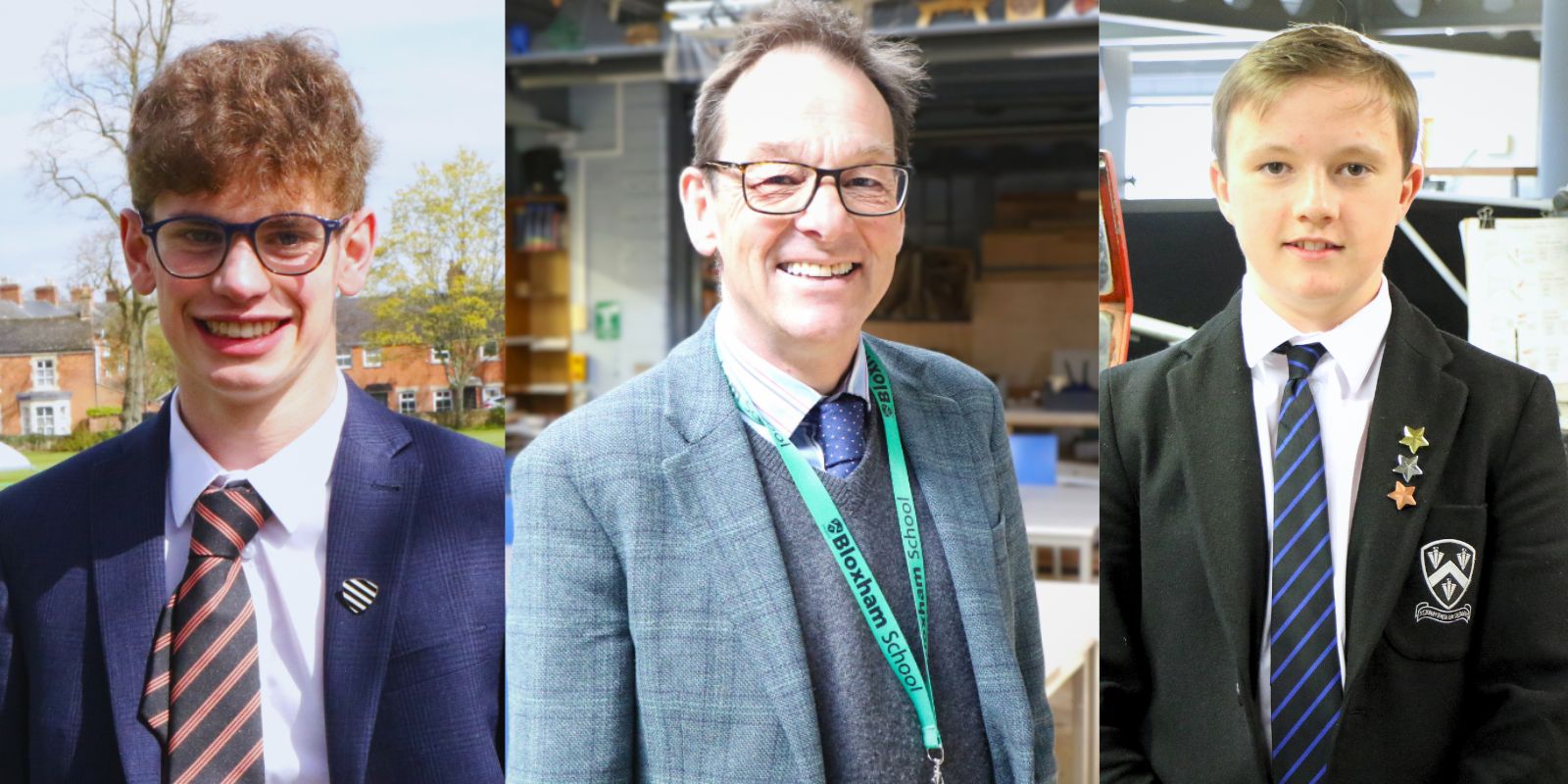DT has long been a hugely popular subject at Bloxham thanks to both the inspirational teachers and the fantastic facilities. We chatted with the brilliant Head of DT, Mark Skevington, as well as Lower Sixth student James and Second Form pupil Freddie, to find out what makes our Bloxham DT department special.

Head of DT Mark Skevington
When you were at school, what did you love about DT, and what inspired you to become a teacher in this subject?
I never did DT at school as a subject, I did woodwork and technical drawing, and I loved it. When I was 13, I had a woodwork teacher who was also a hockey coach who also did sailing, which are my three passions. I thought, that’s not a job, that’s three hobbies and I realised, I wanted his job. I thought if you could go through life just doing your hobbies and being paid for it, that couldn’t be bad. My work still feels like a hobby to this day.
What’s the most exciting project you have ever seen a student make?
There’s a number. About 20 years ago we had a chap called Ben Pauling, who designed and made a pallet wrapping product. He worked on a small farm with his family and they grew high protein hay for the horse racing industry. There were very few employees and they only had one tractor. A horse trainer would order in a bundle of hay and they then had to put it onto a pallet, wrap it in polythene, stick it onto a lorry and deliver it but that took the tractor and both employees. They wanted a manual system for doing this, so Ben designed and developed one. He was really motivated to do it, and did really well.
We entered him for the Young Engineer For Britain competition where he was the U18 national winner and the overall national winner. He was Young Engineer For Britain. He appeared on the BBC news at lunchtime. They interviewed him and said, ‘So, Ben, now you’ve got this amazing award we assume you’re going to be an engineer when you grow up?’ and he said, ‘No, I want to be a surveyor!’
That’s one exciting project. The one I liked the most though was from a chap called Sam Canale-Hopwell. His Grandma was in Katherine House Hospice and Sam visited her a lot there before she died. When he visited, he got to know the chaplain and when his Granny died, Sam asked the chaplain if there was anything he could do in thanks for the support they had given her. The chaplain explained that the chapel they had was a Christian one, but what they needed was a place of worship for any faith, a multi-faith location. He asked Sam to come up with some system or plan to convert this chapel to a multi-faith place of peace and calm and celebration, so that’s what Sam did. He came up with pendants that went in the windows. He did a lot of research, talked to all these faith leaders around Banbury and Oxford, and discovered what motif they each wanted, and they hung in the windows like stained glass. There were seven windows for seven different faiths, and they all had the symbol that most depicted that faith. It was really successful. When it was blessed, we all went to a big celebration and all the faith leaders were there, and the man from Katherine House Hospice stood up and said, what Sam doesn’t know is that now we have been able to make this a multi-faith chapel, we can access two million pounds more in funding because we’re now embracing the whole community. That’s the project which I think has had the most impact.
How do you inspire a love of DT in your pupils?
The thing you have to remember is, it’s not a compulsory subject, so they’ve chosen to do it. Sometimes there’s a reason if people aren’t working hard. I’m not big on detentions. They’re taught via carrot rather than stick, but I almost don’t need to do that because when you make something, it gives you a great pleasure to see that finished project and that’s all you need. It’s self-motivating. I just facilitate their creativity. They want to know how to do something so I show them, and then there are lots of smiley faces when they see the finished work. I’m just always there when they need it.
What’s your best memory from your time at Bloxham?
Getting married to Jacqui in the school chapel – that was a very happy day. There are so may good DT memories. The results are always very good. There was one year where I had 19 pupils in my A level class, and I said that’s way too many, I need help with that or else they’ll all do badly, then 12 of them got A grades! This was before the A*, so that was a good moment.
I did also teach my own children and I loved doing that. Emma, my oldest daughter, did A level many years ago and she was in my class. I gave her the DT prize at the end of the year because she was the best pupil, but she hated me helping her because they all teased her. Teaching my child was a good memory.
Also, helping design the RTC, which opened 26 years ago but still looks amazing. Having the chance to come up with the idea of that, with the architect, was something not every teacher gets. They asked me to come up with the plan so it was exactly to my specification. I’m very grateful for that opportunity. I really ought to stop teaching and retire but I like it too much!

Students
What do you love about your DT lessons?
James (Lower Sixth): When I first joined the school, I didn’t know much about woodwork, only having been around it as a child (my dad is a carpenter). When I joined Bloxham and saw the DT facilities, I thought that I might as well try it. This was a great start to my Bloxham life, because as soon as I got in there, we were working on a project which I absolutely loved. Also, the DT teachers, Mr. Skevington and Mr. Broady-Bennet, have been really helpful over the years teaching me different skills and how to do things most efficiently.
Freddie (Second Form): I have always loved making and designing things and understanding how things work. In our DT lessons we get to do this and learn new skills. The amazing facilities and skilled teachers mean that the opportunities are wide and varied.
If you could make anything in DT, what would you choose?
James: I would design something to help make someone’s life easier, such as a table that moves up and down or something to help an elderly person enjoy their life more if they can’t get out the house as much as they would like to. I would also love to make something for events to be able to get drinks easily out the back of the car while still being able to have a place to put dogs or storage on top.
Freddie: Well, there are many different projects on my list but something I would really like to make is an epoxy dining table. This is a piece of hybrid furniture, made out of wooden planks with epoxy resin in between.
What do you think are the main skills you have learned in DT?
James: One of the key things that you learn is the basic skills of DIY, which means that when you get older you are able to fix things. I have also learnt the skills to be able to make things which help people. An example of this was my GCSE project. I worked endlessly because it was something that I wanted to get right. It was for my Granny who couldn’t plant things because she had had a hip operation and couldn’t hinge to get down. In the end I loved the finished project and my Granny is using it two years after it was made and it is still strong.
Freddie: I have been given the opportunity to learn how to use certain machinery I do not have at home. One of my favourite things is being involved in the Green Electric Car Club where I have learnt new skills such as gear ratios and how to use sustainable resources in my projects.



